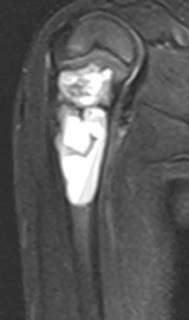T1 weighted images in axial and sagittal plane, T2 FS images in axial plane of an 80 year old male presenting with palpable swelling in the right ventral abdominal wall shows focal herniation of mesenteric / omental fat and vessels through a defect in the right spigelian aponeurosis ( that of the internal oblique and transversus abdominis muscles) inferior to the umbilicus. The hernial sac is covered externally by an intact aponeurosis of the extrenal oblique muscle. There is no herniation of bowel loops through this defect.
- Spigelian Hernia is a hernia through a defect in the aponeurosis of internal oblique and transversus abdominis muscles.
- It is seen seen as a defect in the spigelian aponeurosis lateral to the rectus muscles, inferior to umbilicus where the sheath is deficient posteriorly.
- The external oblique aponeurosis is intact with the hernial sac lying in interparietal/ intermuscular plane
- It is named after a Belgian surgeon-anatomist by the name of Adriaan van den Spiegel although it was first described by KLINKOSCH
- Raveenthiran has described the existence of spigelian hernias with cryptorchidism called the Raveenthiran Syndrome
- It is a rare hernia, approx. 1%( range of 0.2 -2%) of ventral hernias.
- It is commoner on the right side in 4th-7th decade of life.
- It is commoner in females with a male to female ratio of approx. 1:1.18.
- It may be congenital or acquired
- It may be entirely asymptomatic. Its clinical significance lies in the fact that the hernial opening is small predisposing the bowel loops to strangulation/ obstruction. Hence, it is importatnt to repair it. The repair is usually straightforward and rarely requires a mesh prosthesis.
- It is difficult to diagnose clinically, especially in obese patients
- Imaging: USG is often used in conjunction with Valsalva's manouvre in real time to demonstrate the hernia. CT is considered optimal especially with oral contrast. The role of MRI is less described in literature being a more expensive modality. However, with the wider availability of MRI and its better anatomical visualization, it may prove useful in preoperative evaluation as in this patient.
- Differentials are ventral hernias, umbilical hernia, hernia thorugh laparoscopy port etc.
- Harrison LA, Keeshing CA, Martin NL et al. Abdominal wall hernias: Overview of herniography and correlation with cross-sectional imaging. Radiographics 1995; 15(2):315-22.
- Mittal T, Kumar V, Khullar R et al: Diagnosis and management of Spigelian Hernia: A review of literature and our experience. J. Minimum Access Surgery 2008; 4(4): 95-98
- Raveenthiran V. Congenital spigelian hernia with Cryptorchidism: Probably a new syndrome. Hernia 2005; 9(4):378-80
- Federle MP, Jeffrey, RB, Woodward PJ, Borhani AA. Spigelian Hernia. Diagnostic Imaging Abdomen: Second Edition. Amirsys: II-1, 37,2010














